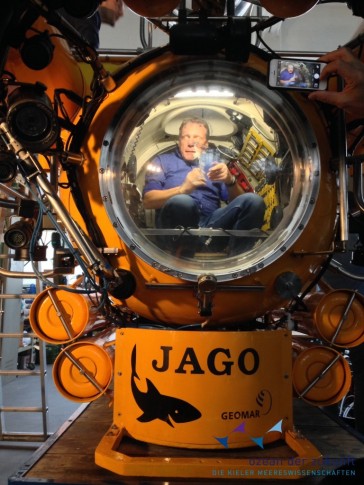When Prof. Martin Visbeck, speaker of the Kiel Cluster of Excellence “The Future Ocean” accepted the invitation by the United Nations Sustainable Development Solutions Network (SDSN) to lead a massive open online course on (MOOC) ocean sustainability, it was a wonderful recognition of the scope of expertise and societal relevance of marine sciences in Kiel.
MOOCs are, as the acronym says, massive (between 15,000 – 50,000 people are expected to register) open online (available to anyone with an internet connection) courses (meaning that education is at the focus). The fact that “massive” also refers to the effort that goes into producing one became apparent to us once the process started. Our long-time partner in scientific outreach, the International Ocean Institute, undertook to sponsor the production and also to contribute with input.
It became clear from the start that this MOOC would use an integrated approach to understanding the challenges and suggesting solutions towards better stewardship of the ocean. Our target audience is early graduate students around the world, but also engaged citizens, decision-makers and educators.
A MOOC does not have a captive audience, as does a university lecture, so the packaging and engagement of the speakers must keep participants glued to the screen. In this we were superbly guided by the production team of “kontentreal” from New York, Karena Albers, Tad Fettig and their colleagues.
Tad placed Martin Visbeck at the end of the diving board at the “Seebar” swimming pavilion on the Kiel Fjord to speak his introductory and concluding remarks. “Look up.. and now just a small step back!” was his way of encouraging Martin to feel comfortable as he set up the cameras and soundman Erik Holland took a voice check. The team was filming “MOOC Number 10 – Oceans. “ And it was clear from the start that we were profiting immensely from the 9 previous MOOCs they had produced for the SDSN educational platform.
Last Friday seven full days of filming came to an end. About 12 hours of film are now being transcribed and will be worked into 55 chapters of 10 minutes each.
The past months paid off – filing scripts, distilling the messages, creating a format that is scientifically enrichening yet widely understandable. And the locations; the pier, the technology center, the submarine JAGO, on a research ship….convey the excitement of marine sciences on screen.

Prof. Colin Devey inside the German research submersible JAGO at GEOMAR. Photo: Avan Antia, The Future Ocean
Prof. Colin Devey inside the German research submersible JAGO at GEOMAR. Photo: Avan Antia, The Future Ocean
The sheer scope of a MOOC, with between 15,000 to 50,000 expected registrations, will give us enormous scope to involve a global community in literacy on the oceans. What about you, reading this blog? What would you expect from an Ocean (Sustainability) MOOC? Add a comment and tell us.
Dr. Avan Antia,